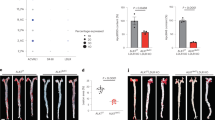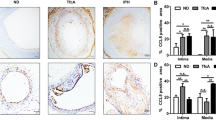Abstract
Objective
Monocyte infiltration into the vessel wall, a process primarily mediated by the interaction between monocyte chemoattractant protein-1 (MCP-1) and its receptor, CCR2, is a key step in atherogenesis. Angiotensin II (Ang II) enhances this monocyte infiltration by increasing the endothelial binding integrin, CD11b. However, the modulation of the Ang II-induced CD11b expression in monocytes in not clear. The aim of this study was to determine if MCP-1/MCP-2 receptor (CCR2) interaction regulates monocyte CD11b expression after 7 days of Ang II infusion.
Methods and results
In ApoE−/− mice continuous subcutaneous infusion of Ang II (0.75 mg/kg/day) for 7 days significantly increased CD11b expression in circulating monocytes as measured by flow cytometry. CD11b expression in ApoE−/− was increased from 135 ± 9 to 176 ± 12 mean fluorescent intensity (MFI), control and Ang II-treated, respectively while in C57B/J wildtype mice CD11b increased from 128 ± 13 to 174 ± 8 MFI, control and Ang II-treated, respectively. Interestingly, co-infusion of either MCP-1 neutralizing antibody (25 μg/kg/day) or a CCR2 antagonist (500 μg/kg/day) with Ang II for 7 days effectively inhibited monocyte CD11b expression and this inhibition was accompanied by a down-regulated vascular infiltration of Mac-2 positive monocyte-derived macrophages.
Conclusion
Our data in the atherogenic ApoE−/− mouse demonstrates that the Ang II induced increase in both monocytic CD11b integrin expression and monocyte vascular infiltration occurs early in atherogenesis. These Ang II-induced monocytic changes are in part regulated through the MCP-1/CCR2 interaction.




Similar content being viewed by others
References
Kher N, Marsh JD. Pathobiology of atherosclerosis—a brief review. Semin Thromb Hemost. 2004;30:665–72.
Lind L. Circulating markers of inflammation and atherosclerosis. Atherosclerosis. 2003;169:203–14.
Egashira K. Molecular mechanisms mediating inflammation in vascular disease: special reference to monocyte chemoattractant protein-1. Hypertension. 2003;41:834–41.
Ikeda U. Inflammation and coronary artery disease. Curr Vasc Pharmacol. 2003;1:65–70.
Ito T, Ikeda U. Inflammatory cytokines and cardiovascular disease. Curr Drug Targets Inflamm Allergy. 2003;2:257–65.
Ulbrich H, Eriksson EE, Lindbom L. Leukocyte and endothelial cell adhesion molecules as targets for therapeutic interventions in inflammatory disease. Trends Pharmacol Sci. 2003;24:640–7.
Baker CS, Gupta S. Chemokines: the link between inflammation, restenosis and atherosclerosis? Int J Cardiol. 2001;80:107–8.
Libby P. What have we learned about the biology of atherosclerosis? The role of inflammation. Am J Cardiol. 2001;88:3J–6J.
Libby P. Coronary artery injury and the biology of atherosclerosis: inflammation, thrombosis, and stabilization. Am J Cardiol. 2000;86:3J–8J.
Berliner JA, Navab M, Fogelman AM, Frank JS, Demer LL, Edwards PA, et al. Atherosclerosis: basic mechanisms. Oxidation, inflammation, and genetics. Circulation. 1995;91:2488–96.
Han KH, Tangirala RK, Green SR, Quehenberger O. Chemokine receptor CCR2 expression and monocyte chemoattractant protein-1-mediated chemotaxis in human monocytes. A regulatory role for plasma LDL. Arterioscler Thromb Vasc Biol 1998;18:1983–91.
Tylaska LA, Boring L, Weng W, Aiello R, Charo IF, Rollins BJ, et al. Ccr2 regulates the level of MCP-1/CCL2 in vitro and at inflammatory sites and controls T cell activation in response to alloantigen. Cytokine. 2002;18:184–90.
Kowala MC, Recce R, Beyer S, Gu C, Valentine M. Characterization of atherosclerosis in LDL receptor knockout mice: macrophage accumulation correlates with rapid and sustained expression of aortic MCP-1/JE. Atherosclerosis. 2000;149:323–30.
Gerszten RE, Garcia-Zepeda EA, Lim YC, Yoshida M, Ding HA, Gimbrone MA Jr, et al. MCP-1 and IL-8 trigger firm adhesion of monocytes to vascular endothelium under flow conditions. Nature. 1999;398:718–23.
Ferrario CM, Strawn WB. Role of the renin–angiotensin–aldosterone system and proinflammatory mediators in cardiovascular disease. Am J Cardiol. 2006;98:121–8.
Mateo T, Abu Nabah YN, Abu TM, Mata M, Cerda-Nicolas M, Proudfoot AE, et al. Angiotensin II-induced mononuclear leukocyte interactions with arteriolar and venular endothelium are mediated by the release of different CC chemokines. J Immunol. 2006;176:5577–86.
Sasaki K, Taniguchi M, Miyoshi M, Goto O, Sato K, Watanabe T. Are transcription factors (NF-{kappa}B and AP-1) involved in the angiotensin II-stimulated production of proinflammatory cytokines induced by LPS in dehydrated rats? Am J Physiol Regul Integr Comp Physiol. 2005;289:R1599–608.
Schiffrin EL, Touyz RM. Inflammation and vascular hypertrophy induced by angiotensin II: role of NADPH oxidase-derived reactive oxygen species independently of blood pressure elevation? Arterioscler Thromb Vasc Biol. 2003;23:707–9.
Virdis A, Schiffrin EL. Vascular inflammation: a role in vascular disease in hypertension? Curr Opin Nephrol Hypertens. 2003;12:181–7.
Phillips MI, Kagiyama S. Angiotensin II as a pro-inflammatory mediator. Curr Opin Investig Drugs. 2002;3:569–77.
Brasier AR, Recinos A III, Eledrisi MS. Vascular inflammation and the renin–angiotensin system. Arterioscler Thromb Vasc Biol. 2002;22:1257–66.
Galle J, Quaschning T. Angiotensin II and atherosclerosis: relevance for renal disease. Contrib Nephrol. 2001;135:235–49.
Prasad A, Koh KK, Schenke WH, Mincemoyer R, Csako G, Fleischer TA, et al. Role of angiotensin II type 1 receptor in the regulation of cellular adhesion molecules in atherosclerosis. Am Heart J. 2001;142:248–53.
Ruiz-Ortega M, Lorenzo O, Suzuki Y, Ruperez M, Egido J. Proinflammatory actions of angiotensins. Curr Opin Nephrol Hypertens. 2001;10:321–9.
Weiss D, Kools JJ, Taylor WR. Angiotensin II-induced hypertension accelerates the development of atherosclerosis in apoE-deficient mice. Circulation. 2001;103:448–54.
Suzuki Y, Ruiz-Ortega M, Egido J. Angiotensin II: a double-edged sword in inflammation. J Nephrol. 2000;13:S101–10.
Kranzhofer R, Browatzki M, Schmidt J, Kubler W. Angiotensin II activates the proinflammatory transcription factor nuclear factor-kappaB in human monocytes. Biochem Biophys Res Commun. 1999;257:826–8.
Chen XL, Tummala PE, Olbrych MT, Alexander RW, Medford RM. Angiotensin II induces monocyte chemoattractant protein-1 gene expression in rat vascular smooth muscle cells. Circ Res. 1998;83:952–9.
Mellado M, Rodriguez-Frade JM, Aragay A, del Real G, Martin AM, Vila-Coro AJ, et al. The chemokine monocyte chemotactic protein 1 triggers Janus kinase 2 activation and tyrosine phosphorylation of the CCR2B receptor. J Immunol. 1998;161:805–13.
Baba M, Nishimura O, Kanzaki N, Okamoto M, Sawada H, Iizawa Y, et al. A small-molecule, nonpeptide CCR5 antagonist with highly potent and selective anti-HIV-1 activity. Proc Natl Acad Sci U S A. 1999;96:5698–703.
Repo H, Jansson SE, Leirisalo-Repo M. Anticoagulant selection influences flow cytometric determination of CD11b upregulation in vivo and ex vivo. J Immunol Methods. 1995;185:65–79.
Charo IF, Taubman MB. Chemokines in the pathogenesis of vascular disease. Circ Res. 2004;95:858–66.
Inoue S, Egashira K, Ni W, Kitamoto S, Usui M, Otani K, et al. Anti-monocyte chemoattractant protein-1 gene therapy limits progression and destabilization of established atherosclerosis in apolipoprotein E-knockout mice. Circulation. 2002;106:2700–6.
Reape TJ, Groot PH. Chemokines and atherosclerosis. Atherosclerosis. 1999;147:213–25.
Watanabe T, Fan J. Atherosclerosis and inflammation mononuclear cell recruitment and adhesion molecules with reference to the implication of ICAM-1/LFA-1 pathway in atherogenesis. Int J Cardiol. 1998;66:S45–53.
Gu L, Rutledge B, Fiorillo J, Ernst C, Grewal I, Flavell R, et al. In vivo properties of monocyte chemoattractant protein-1. J Leukoc Biol. 1997;62:577–80.
Wilcox JN, Nelken NA, Coughlin SR, Gordon D, Schall TJ. Local expression of inflammatory cytokines in human atherosclerotic plaques. J Atheroscler Thromb. 1994;1:S10–3.
Clinton SK, Libby P. Cytokines and growth factors in atherogenesis. Arch Pathol Lab Med. 1992;116:1292–300.
Capers Q, Alexander RW, Lou P, De Leon H, Wilcox JN, Ishizaka N, et al. Monocyte chemoattractant protein-1 expression in aortic tissues of hypertensive rats. Hypertension. 1997;30:1397–402.
Strawn WB, Ferrario CM. Angiotensin II AT1 receptor blockade normalizes CD11b+ monocyte production in bone marrow of hypercholesterolemic monkeys. Atherosclerosis. 2008;196:624–32.
Syrbe U, Moebes A, Scholze J, Swidsinski A, Dorffel Y. Effects of the angiotensin II type 1 receptor antagonist telmisartan on monocyte adhesion and activation in patients with essential hypertension. Hypertens Res. 2007;30:521–8.
Daugherty A, Manning MW, Cassis LA. Antagonism of AT2 receptors augments angiotensin II-induced abdominal aortic aneurysms and atherosclerosis. Br J Pharmacol. 2001;134:865–70.
Nicholson GC, Tennant RC, Carpenter DC, Sarau HM, Kon OM, Barnes PJ, et al. A novel flow cytometric assay of human whole blood neutrophil and monocyte CD11b levels: upregulation by chemokines is related to receptor expression, comparison with neutrophil shape change, and effects of a chemokine receptor (CXCR2) antagonist. Pulm Pharmacol Ther. 2007;20:52–9.
Bush E, Maeda N, Kuziel WA, Dawson TC, Wilcox JN, DeLeon H, et al. CC chemokine receptor 2 is required for macrophage infiltration and vascular hypertrophy in angiotensin II-induced hypertension. Hypertension. 2000;36:360–3.
Conflict of interest
The affiliation of all authors to the sponsor, Pfizer, Inc., is that all authors were former employees of Pfizer and now have either retired or are in new research positions. No conflict of interest has existed or exists now for this submitted work by any of the authors.
Author information
Authors and Affiliations
Corresponding author
Rights and permissions
About this article
Cite this article
Major, T.C., Olszewski, B. & Rosebury-Smith, W.S. A CCR2/CCR5 Antagonist Attenuates an Increase in Angiotensin II-Induced CD11b+ Monocytes from Atherogenic ApoE−/− Mice. Cardiovasc Drugs Ther 23, 113–120 (2009). https://doi.org/10.1007/s10557-008-6157-0
Received:
Accepted:
Published:
Issue Date:
DOI: https://doi.org/10.1007/s10557-008-6157-0




